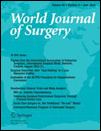Significance of Computed Tomography Finding of Intra-Abdominal Free Fluid Without Solid Organ Injury after Blunt Abdominal Trauma: Time for Laparotomy on Demand
Abstract
Background
Optimal management of patients with intra-abdominal free fluid found on computed tomography (CT) scan without solid organ injury remains controversial.
Objective
The purpose of this study was to determine the significance of CT scan findings of free fluid in the management of blunt abdominal trauma patients who otherwise have no indications for laparotomy.
Methods
During the 3-year study period, all patients presenting with blunt abdominal trauma who underwent abdominal CT examination were retrospectively reviewed. All hemodynamically stable patients who presented with abdominal free fluid without solid organ injury on CT scan were analyzed for radiological interpretation, clinical management, operative findings, and outcome.
Results
A total of 122 patients were included in the study, 91 % of whom were males. The mean age of the patients was 33 ± 12 years. A total of 34 patients underwent exploratory laparotomy, 31 of whom had therapeutic interventions. Small bowel injuries were found in 12 patients, large bowel injuries in ten, and mesenteric injuries in seven patients. One patient had combined small and large bowel injury, and one had traumatic gangrenous appendix. In the remaining three patients, laparotomy was non-therapeutic. A total of 36 patients had associated pelvic fractures and 33 had multiple lumbar transverse process fractures.
Conclusion
Detection of intra-peritoneal fluid by CT scan is inaccurate for prediction of bowel injury or need for surgery. However, the correlation between CT scan findings and clinical course is important for optimal diagnosis of bowel and mesenteric injuries.




